Unit9 From Here to There Grammar in use 单词详解+课文讲解 课件(共50张PPT)仁爱科普版(2024)七年级英语下册
文档属性
| 名称 | Unit9 From Here to There Grammar in use 单词详解+课文讲解 课件(共50张PPT)仁爱科普版(2024)七年级英语下册 | 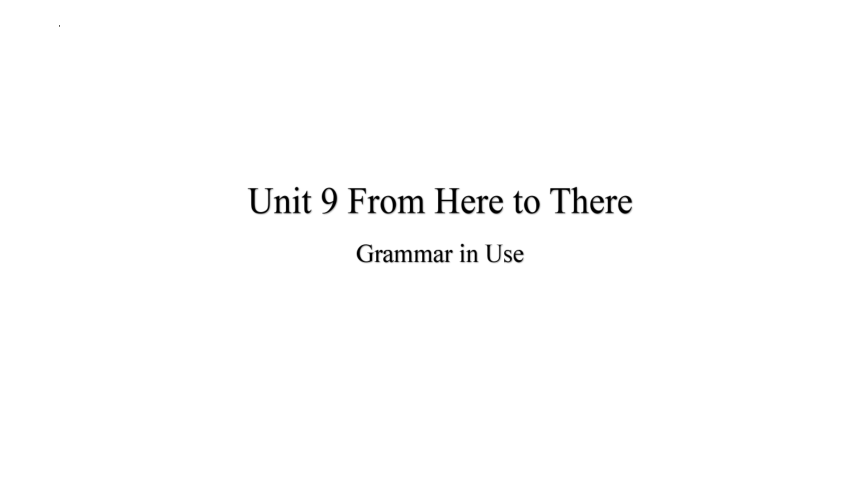 | |
| 格式 | pptx | ||
| 文件大小 | 38.8MB | ||
| 资源类型 | 教案 | ||
| 版本资源 | 仁爱科普版 | ||
| 科目 | 英语 | ||
| 更新时间 | 2025-04-21 21:47:03 | ||
图片预览


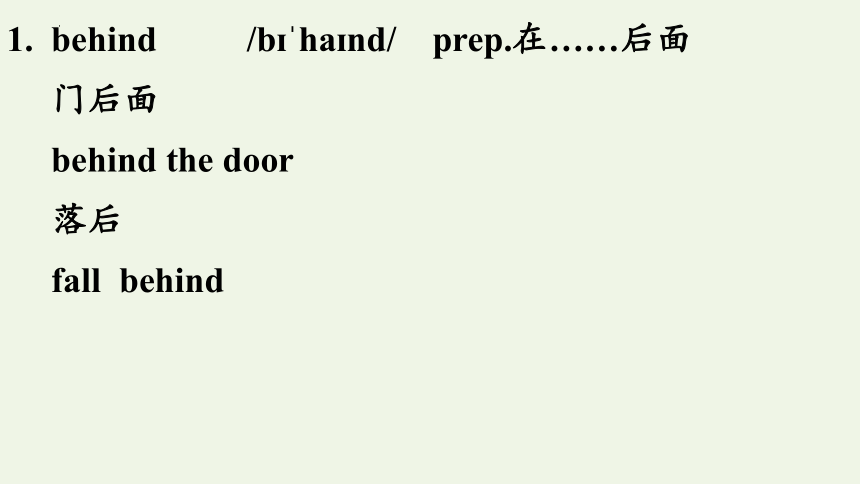

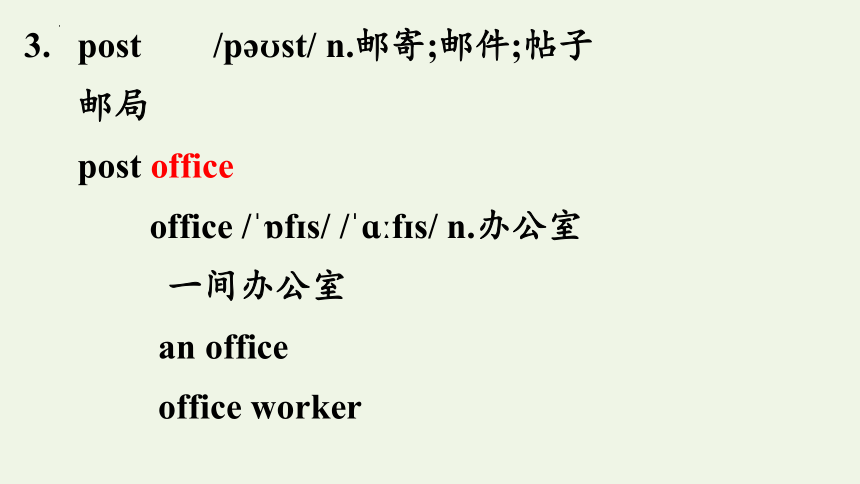
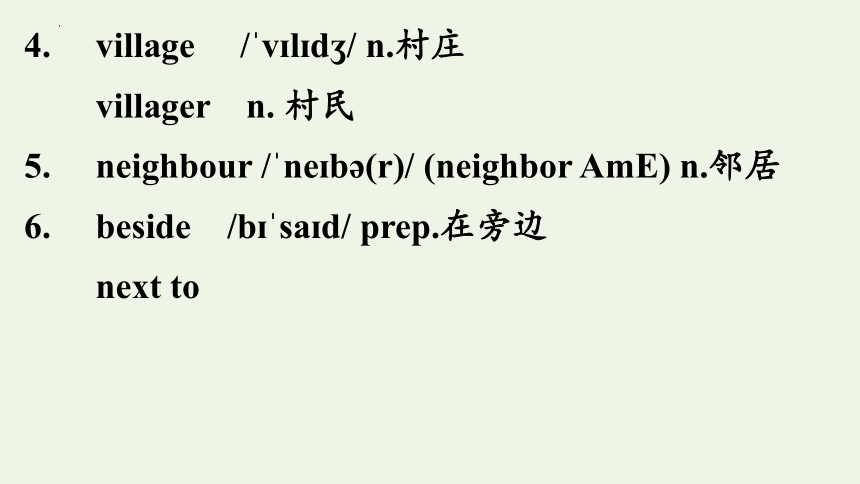

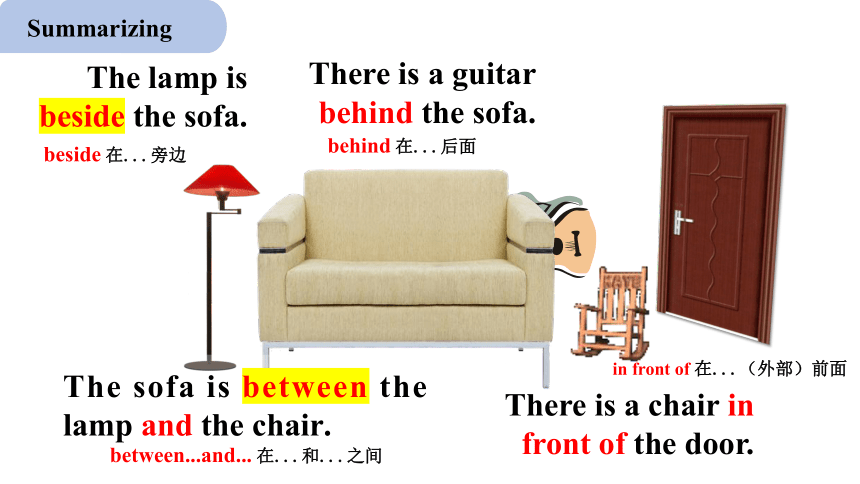

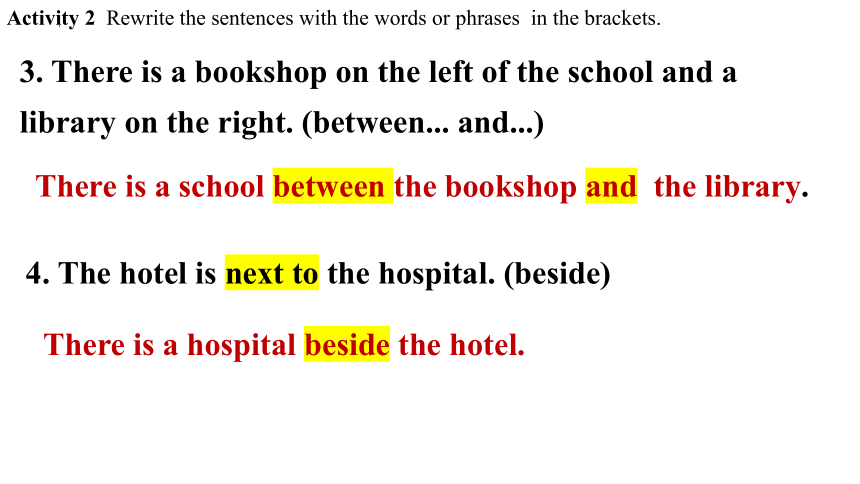
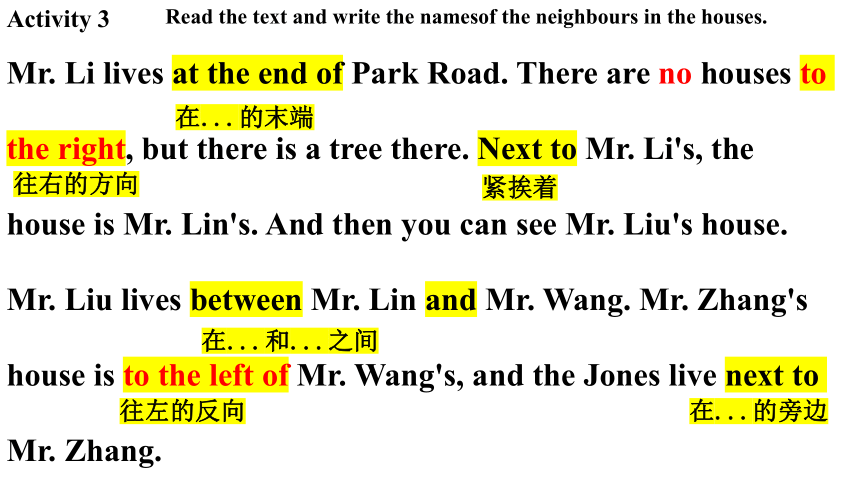
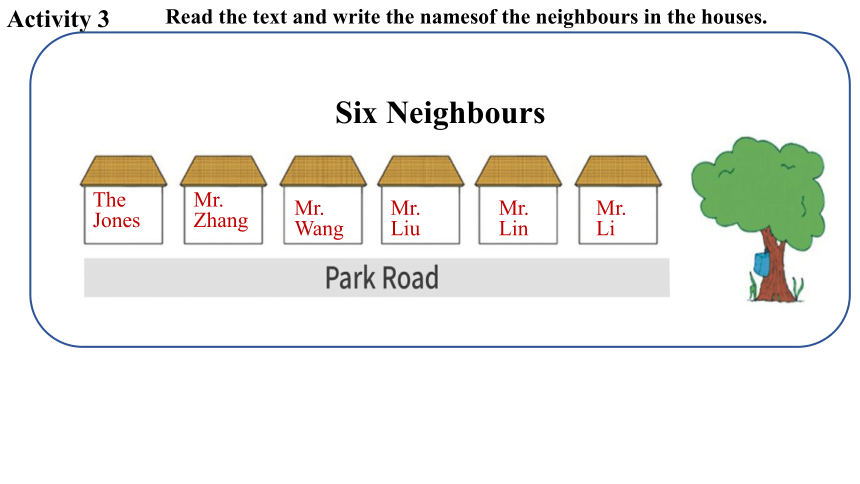
文档简介
(共50张PPT)
Unit 9 From Here to There
Grammar in Use
Learning Objectives
In this class, you will
理解介词的形式、意义和用法
在语境中学习动词一般过去时的形式和意义
在语境中正确使用一般过去时
Grammar in Use
1. behind /b ha nd/ prep.在……后面
门后面
behind the door
落后
fall behind
2. front /fr nt/ n.前面;前部
在...前面
in front of
教学楼前有一棵树
There is a tree in front of the teaching building.
用behind 改写
There is a teaching building behind the tree.
3. post /p st/ n.邮寄;邮件;帖子
邮局
post office
office / f s/ / ɑ f s/ n.办公室
一间办公室
an office
office worker
4. village / v l d / n.村庄
villager n. 村民
5. neighbour / ne b (r)/ (neighbor AmE) n.邻居
6. beside /b sa d/ prep.在旁边
next to
The girl
is standing
behind the door.
There is a lake in front of the teaching building.
Go arcoss the bridge, and you can find the zoo on your right.
Activity 1
Look at the pictures and read the sentences. Pay attention to the prepositions in bold.
Summarizing
There is a chair in front of the door.
There is a guitar behind the sofa.
The lamp is beside the sofa.
The sofa is between the lamp and the chair.
beside 在...旁边
between...and... 在...和...之间
behind 在...后面
in front of 在...(外部)前面
Activity 2 Rewrite the sentences with the words or phrases in the brackets.
1. The post office is on the left of the shopping mall.(on the right of)
2. There is a village in front of the mountain. (behind)
The shopping mall is on the right of the post office.
There is a mountain behind the village.
post office 邮局
village /v l d / 村庄
Activity 2 Rewrite the sentences with the words or phrases in the brackets.
3. There is a bookshop on the left of the school and a library on the right. (between... and...)
4. The hotel is next to the hospital. (beside)
There is a school between the bookshop and the library.
There is a hospital beside the hotel.
Activity 3
Read the text and write the namesof the neighbours in the houses.
Mr. Li lives at the end of Park Road. There are no houses to the right, but there is a tree there. Next to Mr. Li's, the house is Mr. Lin's. And then you can see Mr. Liu's house. Mr. Liu lives between Mr. Lin and Mr. Wang. Mr. Zhang's house is to the left of Mr. Wang's, and the Jones live next to Mr. Zhang.
在...的末端
紧挨着
在...和...之间
往右的方向
往左的反向
在...的旁边
Activity 3
Read the text and write the namesof the neighbours in the houses.
Six Neighbours
The Jones
Mr.
Zhang
Mr.
Wang
Mr.
Liu
Mr.
Lin
Mr.
Li
一般过去时
1. happen / h p n/ v.发生;碰巧
1) sth. happen(s) to sb. 某事发生在某人身上
What happened to you just now
2) happen to do sth. 碰巧做某事
2. community /k mju n ti/ n.社区
find the way to your community
找到去你社区的路
3. add / d/ v.增加;添加
Please add some sugar to my coffee.
4. cry /kra / v.喊叫;哭 n.叫喊,叫声
过去式 cried
1) She cried out for help.
2) I heard a cry in the night.
添加
大声喊叫
叫声
5. care /ke (r)/ /ker/
v.关注,在意;关心,关怀
n.照料,护理;小心,谨慎
1) I don’t care about that.
2) Take care of your health.
6. suddenly / s d nli/ adv.突然;忽然
Suddenly, it started to rain.
7. shake / e k/ v.摇动;抖动
过去式 shook
1) shake hands 握手
2) shake the tree 摇动树
8. sit /s t/ v.坐
过去式 sat
Sit down, please. 请坐
July 12th, 1999
-When was she born
-She was born on July 12th, 1999.
August 1st, 2013
- When were you born
- I was born on August 1st, 2013.
am, is---was;
are ---were
he could one year ago
He could ride a bike one year ago.
can ---could
Mr. Lee often _____ the piano.
Mr. Lee now play
Mr. Lee _________ the piano now.
Mr. Lee often
Mr. Lee ______ the piano yesterday.
Mr. Lee yesterday
is playing
plays
played
一般过去时:
1. 定义 表示过去某一段时间内经常、反复发生的动作。
当我5岁时,我妈妈经常带我去公园。
My mother often took me to the park
when I was five years old.
当吴老师是个学生时,她总是放学读英语。
When Miss Wu was a student, she always read
English after school.
一般过去 式 ,可与以下时间搭配: before以前,
① X years/months/ days/weeks ago
几年/几个月/ 几天/几星期前;
② when he/she was…years old
当某人几岁的时候; =at the age of ….. ;
③ in the past在过去;
一般过去式 ,可与以下时间搭配: before以前,
④ last year/ month/ week/ night
(去年/上个月/上周/ 昨晚);
⑤ yesterday 昨天 ,
the day before yesterday 前天
just now 刚才
动词过去式的构成
1. 一般在动词末尾加- ed
如:look
play
walk
clean
looked
played
walked
cleaned
(一) 规则变化
2. 以不发音的e结尾的动词,直接加- d
如: like
live
dance
use
liked
lived
danced
used
3.以一个辅音字母结尾的重读闭音节,先双写辅音字母,再加- ed
如: stop
plan
shop
stopped
planned
shopped
4.以辅音字母加y结尾的动词,改y为i,再加- ed
如: study
worry
cry
carry
studied
worried
cried
carried
词尾- ed的读音
清辅音后面: /t/ eg. cooked, finished
在浊辅音和元音后面:/d/ eg. called, played
3. 在/t/, /d/ 后面:/id/ eg. wanted, needed
danced, cooked, finished, worked
called, played, learned
wanted, rented, needed
/t/
/d/
/id/
Activity 3
Listen to the words. Pay attention to the pronunciation of the underlined letters.
/-d/ enjoyed played lived planned opened
/-t/ stopped looked jumped finished washed
/- d/ acted wanted planted decided studied
1. 有些动词的过去式是其本身
如: put
hurt
let
read ([ri:d])
cost
put
hurt
let
read ([red])
(二) 不规则变化
cost
2. 可以找到相似处的变化规律
如:bring
buy
think
brought
bought
thought
2. 可以找到相似处的变化规律
如:catch
teach
caught
taught
2. 可以找到相似处的变化规律
如:begin
drink
give
sing
swim
run
began
drank
gave
sang
swam
ran
sit
see
sat
saw
2. 可以找到相似处的变化规律
如:draw
blow
fly
know
drew
blew
flew
knew
2. 不规则动词表P148
如: is / am
are
go
do
come
have
was
were
went
did
came
had
Regular verbs
Activity 2 Study the rules for forming the past tense of the verbs and complete the table.
Rules Examples Rules Examples
add -ed watch-watched visit- ________ change -y to -i and add -ed carry-carried
cry- _______
add -d care-cared love- ____ add -ed play-played
enjoy- ______
double the last consonant and add -ed plan-planned stop- ________
Irregular verbs begin-began take-took say- __________ teach- _________ visited
loved
cried
enjoyed
stopped
said
taught
Summarizing
动词的过去式的构成
动词过去式的构成:
(1)规则动词过去式的构成有四条规则:
①一般在动词原形末尾直接加上-ed。
②以不发音的字母e结尾的动词,去e再加-ed。
③末尾只有一个辅音字母的重读闭音节,先双写这个辅音字母,再加-ed。
④末尾是辅音字母+y结尾的动词,先变y为i,然后再加-ed。
(2)不规则动词的过去式需特殊记忆。
Activity 3
Look at the pictures and complete the text with the correct form of the given words.
Last Sunday, Xiao Ya went camping with her mom and her sister Xiao Mei. They first ________ (try) to put up a tent. Suddenly, there was a heavy wind and the tent ________ (fly) into the air. “Please go and find it,” their mom said.
tried
flew
去野营
搭帐篷
一场大风
Xiao Ya and Xiao Mei went to look for the tent and then Xiao Mei _______ (cry) out, “Look, it is in the tree.” Xiao Ya looked up and _______ (see) it. She ________ (shake) the tree and the tent fell down. They brought the tent back. They then ________ (put) up the tent together. Beside the tent, they also ______ (build) a fire. They sat around the fire and had a great time.
cried
saw
shook
put
built
大声喊
向上看
摔倒
把帐篷带回来
生火
围火而坐
一般过去时的各种句型
Observing
Activity 1
Pair work. Read the conversation. Pay attention to the simple past tense of verbs.
Kangkang, what happened to you just now?
What did you do then
I didn't find the way to your community. I was lost.
I asked an old man for help. He told me the way.
1. I was at home yesterday.
I wasn’t at home yesterday.
Were you at home yesterday
Yes, I was. No, I wasn’t.
Where were you yesterday
2. He was sad last night.
He wasn’t sad last night.
Was he sad last night
Yes, he was. No, he wasn’t.
否定句:
否定句:
一般疑问句:
一般疑问句:
划线提问:
回答:
回答:
3. They had a football game an hour ago.
They didn’t have a football game an hour ago.
Did they have a football game an hour ago
Yes, they did. / No, they didn’t.
否定句:
一般疑问句:
肯否回答:
划线提问:
1. What did they do an hour ago
2. When did they have a football game
4. I had a big dinner last night.
I didn’t have a big dinner last night.
Did you have a big dinner last night
Yes, I did. No, I didn’t.
What did you do last night
5. He went shopping last Sunday.
He didn’t go shopping last Sunday.
Did he go shopping last Sunday
Yes, he did. No, he didn’t.
What did he do last Sunday
否定句:
否定句:
一般疑问句:
一般疑问句:
划线提问:
划线提问:
回答:
回答:
Summary
3. 一般过去时的几种句型
肯定句:主语+动词的过去式+其他.
否定句:主语+did not (didn’t)+动词原形+其他.
一般疑问句:Did+ 主语 + 动词原形 + 其他?
肯否回答: Yes , 主语 did. No, 主语 didn’t
特殊疑问句:What/ When/ Where+did + 主语+动词原形+其他?
Summary
一般过去时口诀
一般过去时并不难,表示过去动作、状态记心间。
动词要用过去式,时间状语句末站。
否定句很简单,didn’t 站在动词原形前,其他部分不要变。
一般疑问句也好变,did放在句子前,主语、动词原形、其他部分依次站。
特殊疑问句也简单,疑问词加一般疑问句记心间。
最后一条请注意,动词过去式要牢记。
Summarizing
规则动词 (Regular Verbs)的过去式
一般的直接在词尾+ -ed
以不发音的e结尾的动词在词尾+ -d
以ie结尾的动词直接+d
以一个元音字母+一个辅音字母结尾的重读闭音节动词,先双写结尾的辅音字母再+-ed
以辅音字母+y结尾的动词,先把y变成i,再+ed
want-wanted work-worked
like-liked live-lived
die-died tie-tied
plan-planned stop-stopped
study-studied
worry-worried
Summary
We learn:
1. some words and phrases about prepositions of locality.
2. the rules for forming the past tense of the verbs.
3. the usage of the simple past tense.
We can:
1. express the position of some places by using some words and phrases
about prepositions of locality..
2. use the simple past tense correctly.
Homework
You should:
1. Review the words and phrases in this lesson.
2. Review the rules for forming the past tense of verbs and the usage of the simple past tense.
3. Describe the things in your bedroom or study, using prepositions and prepositional phrases.
You can:
Write a short passage bout what you did last weekend.
Unit 9 From Here to There
Grammar in Use
Learning Objectives
In this class, you will
理解介词的形式、意义和用法
在语境中学习动词一般过去时的形式和意义
在语境中正确使用一般过去时
Grammar in Use
1. behind /b ha nd/ prep.在……后面
门后面
behind the door
落后
fall behind
2. front /fr nt/ n.前面;前部
在...前面
in front of
教学楼前有一棵树
There is a tree in front of the teaching building.
用behind 改写
There is a teaching building behind the tree.
3. post /p st/ n.邮寄;邮件;帖子
邮局
post office
office / f s/ / ɑ f s/ n.办公室
一间办公室
an office
office worker
4. village / v l d / n.村庄
villager n. 村民
5. neighbour / ne b (r)/ (neighbor AmE) n.邻居
6. beside /b sa d/ prep.在旁边
next to
The girl
is standing
behind the door.
There is a lake in front of the teaching building.
Go arcoss the bridge, and you can find the zoo on your right.
Activity 1
Look at the pictures and read the sentences. Pay attention to the prepositions in bold.
Summarizing
There is a chair in front of the door.
There is a guitar behind the sofa.
The lamp is beside the sofa.
The sofa is between the lamp and the chair.
beside 在...旁边
between...and... 在...和...之间
behind 在...后面
in front of 在...(外部)前面
Activity 2 Rewrite the sentences with the words or phrases in the brackets.
1. The post office is on the left of the shopping mall.(on the right of)
2. There is a village in front of the mountain. (behind)
The shopping mall is on the right of the post office.
There is a mountain behind the village.
post office 邮局
village /v l d / 村庄
Activity 2 Rewrite the sentences with the words or phrases in the brackets.
3. There is a bookshop on the left of the school and a library on the right. (between... and...)
4. The hotel is next to the hospital. (beside)
There is a school between the bookshop and the library.
There is a hospital beside the hotel.
Activity 3
Read the text and write the namesof the neighbours in the houses.
Mr. Li lives at the end of Park Road. There are no houses to the right, but there is a tree there. Next to Mr. Li's, the house is Mr. Lin's. And then you can see Mr. Liu's house. Mr. Liu lives between Mr. Lin and Mr. Wang. Mr. Zhang's house is to the left of Mr. Wang's, and the Jones live next to Mr. Zhang.
在...的末端
紧挨着
在...和...之间
往右的方向
往左的反向
在...的旁边
Activity 3
Read the text and write the namesof the neighbours in the houses.
Six Neighbours
The Jones
Mr.
Zhang
Mr.
Wang
Mr.
Liu
Mr.
Lin
Mr.
Li
一般过去时
1. happen / h p n/ v.发生;碰巧
1) sth. happen(s) to sb. 某事发生在某人身上
What happened to you just now
2) happen to do sth. 碰巧做某事
2. community /k mju n ti/ n.社区
find the way to your community
找到去你社区的路
3. add / d/ v.增加;添加
Please add some sugar to my coffee.
4. cry /kra / v.喊叫;哭 n.叫喊,叫声
过去式 cried
1) She cried out for help.
2) I heard a cry in the night.
添加
大声喊叫
叫声
5. care /ke (r)/ /ker/
v.关注,在意;关心,关怀
n.照料,护理;小心,谨慎
1) I don’t care about that.
2) Take care of your health.
6. suddenly / s d nli/ adv.突然;忽然
Suddenly, it started to rain.
7. shake / e k/ v.摇动;抖动
过去式 shook
1) shake hands 握手
2) shake the tree 摇动树
8. sit /s t/ v.坐
过去式 sat
Sit down, please. 请坐
July 12th, 1999
-When was she born
-She was born on July 12th, 1999.
August 1st, 2013
- When were you born
- I was born on August 1st, 2013.
am, is---was;
are ---were
he could one year ago
He could ride a bike one year ago.
can ---could
Mr. Lee often _____ the piano.
Mr. Lee now play
Mr. Lee _________ the piano now.
Mr. Lee often
Mr. Lee ______ the piano yesterday.
Mr. Lee yesterday
is playing
plays
played
一般过去时:
1. 定义 表示过去某一段时间内经常、反复发生的动作。
当我5岁时,我妈妈经常带我去公园。
My mother often took me to the park
when I was five years old.
当吴老师是个学生时,她总是放学读英语。
When Miss Wu was a student, she always read
English after school.
一般过去 式 ,可与以下时间搭配: before以前,
① X years/months/ days/weeks ago
几年/几个月/ 几天/几星期前;
② when he/she was…years old
当某人几岁的时候; =at the age of ….. ;
③ in the past在过去;
一般过去式 ,可与以下时间搭配: before以前,
④ last year/ month/ week/ night
(去年/上个月/上周/ 昨晚);
⑤ yesterday 昨天 ,
the day before yesterday 前天
just now 刚才
动词过去式的构成
1. 一般在动词末尾加- ed
如:look
play
walk
clean
looked
played
walked
cleaned
(一) 规则变化
2. 以不发音的e结尾的动词,直接加- d
如: like
live
dance
use
liked
lived
danced
used
3.以一个辅音字母结尾的重读闭音节,先双写辅音字母,再加- ed
如: stop
plan
shop
stopped
planned
shopped
4.以辅音字母加y结尾的动词,改y为i,再加- ed
如: study
worry
cry
carry
studied
worried
cried
carried
词尾- ed的读音
清辅音后面: /t/ eg. cooked, finished
在浊辅音和元音后面:/d/ eg. called, played
3. 在/t/, /d/ 后面:/id/ eg. wanted, needed
danced, cooked, finished, worked
called, played, learned
wanted, rented, needed
/t/
/d/
/id/
Activity 3
Listen to the words. Pay attention to the pronunciation of the underlined letters.
/-d/ enjoyed played lived planned opened
/-t/ stopped looked jumped finished washed
/- d/ acted wanted planted decided studied
1. 有些动词的过去式是其本身
如: put
hurt
let
read ([ri:d])
cost
put
hurt
let
read ([red])
(二) 不规则变化
cost
2. 可以找到相似处的变化规律
如:bring
buy
think
brought
bought
thought
2. 可以找到相似处的变化规律
如:catch
teach
caught
taught
2. 可以找到相似处的变化规律
如:begin
drink
give
sing
swim
run
began
drank
gave
sang
swam
ran
sit
see
sat
saw
2. 可以找到相似处的变化规律
如:draw
blow
fly
know
drew
blew
flew
knew
2. 不规则动词表P148
如: is / am
are
go
do
come
have
was
were
went
did
came
had
Regular verbs
Activity 2 Study the rules for forming the past tense of the verbs and complete the table.
Rules Examples Rules Examples
add -ed watch-watched visit- ________ change -y to -i and add -ed carry-carried
cry- _______
add -d care-cared love- ____ add -ed play-played
enjoy- ______
double the last consonant and add -ed plan-planned stop- ________
Irregular verbs begin-began take-took say- __________ teach- _________ visited
loved
cried
enjoyed
stopped
said
taught
Summarizing
动词的过去式的构成
动词过去式的构成:
(1)规则动词过去式的构成有四条规则:
①一般在动词原形末尾直接加上-ed。
②以不发音的字母e结尾的动词,去e再加-ed。
③末尾只有一个辅音字母的重读闭音节,先双写这个辅音字母,再加-ed。
④末尾是辅音字母+y结尾的动词,先变y为i,然后再加-ed。
(2)不规则动词的过去式需特殊记忆。
Activity 3
Look at the pictures and complete the text with the correct form of the given words.
Last Sunday, Xiao Ya went camping with her mom and her sister Xiao Mei. They first ________ (try) to put up a tent. Suddenly, there was a heavy wind and the tent ________ (fly) into the air. “Please go and find it,” their mom said.
tried
flew
去野营
搭帐篷
一场大风
Xiao Ya and Xiao Mei went to look for the tent and then Xiao Mei _______ (cry) out, “Look, it is in the tree.” Xiao Ya looked up and _______ (see) it. She ________ (shake) the tree and the tent fell down. They brought the tent back. They then ________ (put) up the tent together. Beside the tent, they also ______ (build) a fire. They sat around the fire and had a great time.
cried
saw
shook
put
built
大声喊
向上看
摔倒
把帐篷带回来
生火
围火而坐
一般过去时的各种句型
Observing
Activity 1
Pair work. Read the conversation. Pay attention to the simple past tense of verbs.
Kangkang, what happened to you just now?
What did you do then
I didn't find the way to your community. I was lost.
I asked an old man for help. He told me the way.
1. I was at home yesterday.
I wasn’t at home yesterday.
Were you at home yesterday
Yes, I was. No, I wasn’t.
Where were you yesterday
2. He was sad last night.
He wasn’t sad last night.
Was he sad last night
Yes, he was. No, he wasn’t.
否定句:
否定句:
一般疑问句:
一般疑问句:
划线提问:
回答:
回答:
3. They had a football game an hour ago.
They didn’t have a football game an hour ago.
Did they have a football game an hour ago
Yes, they did. / No, they didn’t.
否定句:
一般疑问句:
肯否回答:
划线提问:
1. What did they do an hour ago
2. When did they have a football game
4. I had a big dinner last night.
I didn’t have a big dinner last night.
Did you have a big dinner last night
Yes, I did. No, I didn’t.
What did you do last night
5. He went shopping last Sunday.
He didn’t go shopping last Sunday.
Did he go shopping last Sunday
Yes, he did. No, he didn’t.
What did he do last Sunday
否定句:
否定句:
一般疑问句:
一般疑问句:
划线提问:
划线提问:
回答:
回答:
Summary
3. 一般过去时的几种句型
肯定句:主语+动词的过去式+其他.
否定句:主语+did not (didn’t)+动词原形+其他.
一般疑问句:Did+ 主语 + 动词原形 + 其他?
肯否回答: Yes , 主语 did. No, 主语 didn’t
特殊疑问句:What/ When/ Where+did + 主语+动词原形+其他?
Summary
一般过去时口诀
一般过去时并不难,表示过去动作、状态记心间。
动词要用过去式,时间状语句末站。
否定句很简单,didn’t 站在动词原形前,其他部分不要变。
一般疑问句也好变,did放在句子前,主语、动词原形、其他部分依次站。
特殊疑问句也简单,疑问词加一般疑问句记心间。
最后一条请注意,动词过去式要牢记。
Summarizing
规则动词 (Regular Verbs)的过去式
一般的直接在词尾+ -ed
以不发音的e结尾的动词在词尾+ -d
以ie结尾的动词直接+d
以一个元音字母+一个辅音字母结尾的重读闭音节动词,先双写结尾的辅音字母再+-ed
以辅音字母+y结尾的动词,先把y变成i,再+ed
want-wanted work-worked
like-liked live-lived
die-died tie-tied
plan-planned stop-stopped
study-studied
worry-worried
Summary
We learn:
1. some words and phrases about prepositions of locality.
2. the rules for forming the past tense of the verbs.
3. the usage of the simple past tense.
We can:
1. express the position of some places by using some words and phrases
about prepositions of locality..
2. use the simple past tense correctly.
Homework
You should:
1. Review the words and phrases in this lesson.
2. Review the rules for forming the past tense of verbs and the usage of the simple past tense.
3. Describe the things in your bedroom or study, using prepositions and prepositional phrases.
You can:
Write a short passage bout what you did last weekend.
同课章节目录
